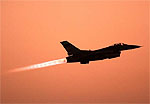Air Force F-16s fly the most sorties against ISIS, B-1s drop most bombs
 The Air Force has flown more than half of the 87,000 coalition sorties over Iraq and Syria since the air campaign against the Islamic State militant group began, striking key locations and assets about 25 times a day, Lt. Gen. John Raymond told reporters Thursday.
The Air Force has flown more than half of the 87,000 coalition sorties over Iraq and Syria since the air campaign against the Islamic State militant group began, striking key locations and assets about 25 times a day, Lt. Gen. John Raymond told reporters Thursday.
That number may increase in the weeks ahead as Iraqi forces advance to reclaim Mosul, the most populous city in the territory held by ISIS.
“We have conducted 67 percent of the nearly 11,000 airstrikes,” said Raymond, deputy chief of staff for Air Force operations. “From F-15s to F-22s to A-10s to B-1s to [remotely piloted aircraft], we use all of the aircraft to meet the ... demands of the mission at hand.”
Military officials, from Gen. Herbert “Hawk” Carlisle, head of Air Combat Command, to Lt. Gen. Charles Brown Jr., commander of U.S. Air Forces Central Command, have heralded the Air Force’s performance against the Islamic State, from the successful intelligence, surveillance and reconnaissance missions flown by the F-22 Raptor to the ability of the A-10 Thunderbolt to destroy the Islamic State's oil and cash reserves.
The B-1 bomber can lay claim to the title for the U.S. aircraft to release the most ordnance since Operation Inherent Resolve, the Pentagon’s name for the campaign, began in 2014, according to Air Force Central Command statistics of manned aircraft provided to Air Force Times.
The decades-old bomber has dropped almost 40 percent of the Air Force bombs on Islamic State targets, according to the service's statistics. Unsurprisingly, this correlates with the B-1’s 75,000-pound payload capacity, which can include both precision-guided and and non-precision weapons.
“Pretty much any target that the enemy would have, we’ll have the type of weapons and the number of weapons to make sure that it's going to be a first look, a successful strike that eliminates that target from the battle space,” a lieutenant colonel, identified only as “Joseph,” recently told Air Force Times.
Joseph was the commander of a B-1 crew with the 37th Bomb Squadron out of Ellsworth Air Force Base, South Dakota, that returned in January from a six-month deployment to the Middle East.
“We only do precision,” Joseph continued. “We want to be deliberate. A precise weapon ... allows us to strike the area that we’ve been tasked to, identified as an enemy target.”
But the B-1 is not the aircraft that takes to the skies most often. The F-16 flies about a third of the Air Force's sorties over Iraq and Syria, with the F-15E coming in a close second.
With limited numbers of the F-22 in the AOR, the Raptor flies far fewer sorties, and drops much less ordnance, than the other platforms.
Air Force officials claim the air campaign against ISIS has been one of the most precise air wars in history, thanks in large part to precision-guided weapons.
“Daesh doesn't actually mass itself where you could actually even use [non-precision weapons]. ... That's a tactic that is really not effective for the fight we're actually executing today," Brown, the head of AFCENT, said Feb. 19, using the Pentagon's alternative name for the Islamic State group.
But a March 19 attack on buildings at the University of Mosul in Iraq, an ISIS headquarters, may have killed dozens of civilians in addition to the militants targeted, according to airwars.org. The United Kingdom-based organization monitors international airstrikes against the Islamic State and other groups in Iraq and Syria, and assesses claims of civilian casualties.
The group asserts that the Pentagon has badly underestimated the number of civilian casualties resulting from the Inherent Resolve air campaign.
“We’re continually looking at our processes and trying to determine the most effective way to hit the enemy with minimal impact on civilians," Air Force Col. Patrick Ryder, a spokesman for CENTCOM, said in January. "The low numbers are a testament to our aviators, mission planners…and intelligence analysts.”
“This is the most precise air campaign in history,” Ryder continued, and “there is a very detailed process we go through to plan these targets.”